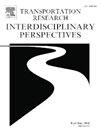日本国内航空运输网络的延误传播模式
IF 3.9
Q2 TRANSPORTATION
Transportation Research Interdisciplinary Perspectives
Pub Date : 2024-09-01
DOI:10.1016/j.trip.2024.101235
引用次数: 0
摘要
我们每天都会遇到空中交通延误,但这些延误是否有重复发生的规律?在本研究中,我们通过整合延迟因果关系网络和时间网络分析,研究了 2019 年日本国内航空运输网络延迟传播模式的反复性。此外,我们还通过比较延迟因果网络和有向配置模型生成的相应随机网络,研究了延迟传播的独特特征。结果,我们发现延迟传播模式的结构可分为几组。这些组在总延迟时间和平均外度方面存在显著的统计学差异,不同的机场在延迟传播中发挥着核心作用。研究结果还表明,一些延误传播模式在一年中的特定时段尤为突出,这可能受到日本季节和地理因素的影响。此外,我们还发现,在延误因果关系网络中,特定网络主题出现的频率明显高于(或低于)其相应的随机对应物。这一特征在延迟较严重的组中尤为明显。这些结果表明,延误是按照特定的方向模式传播的,这对预测空中交通延误有很大帮助。我们希望本研究能引发对空中交通延误传播的经常性和非经常性的进一步研究。本文章由计算机程序翻译,如有差异,请以英文原文为准。
Delay propagation patterns in Japan’s domestic air transport network
We experience air traffic delays every day, but are there any recurrent patterns in these delays? In this study, we investigate the recurrence of delay propagation patterns in Japan’s domestic air transport network in 2019 by integrating delay causality networks and temporal network analysis. Additionally, we examine characteristics unique to delay propagation by comparing delay causality networks with corresponding randomized networks generated by a directed configuration model. As a result, we found that the structure of the delay propagation patterns can be classified into several groups. The identified groups exhibit statistically significant differences in total delay time and average out-degree, with different airports playing central roles in spreading delays. The results also suggest that some delay propagation patterns are particularly prominent during specific times of the year, which could be influenced by Japan’s seasonal and geographical factors. Moreover, we discovered that specific network motifs appear significantly more (or less) frequently in delay causality networks than their corresponding randomized counterparts. This characteristic is particularly pronounced in groups with more significant delays. These results suggest that delays propagate following specific directional patterns, which could significantly contribute to predicting air traffic delays. We expect the present study to trigger further research on recurrent and non-recurrent natures of air traffic delay propagation.
求助全文
通过发布文献求助,成功后即可免费获取论文全文。
去求助
来源期刊

Transportation Research Interdisciplinary Perspectives
Engineering-Automotive Engineering
CiteScore
12.90
自引率
0.00%
发文量
185
审稿时长
22 weeks
 求助内容:
求助内容: 应助结果提醒方式:
应助结果提醒方式:


